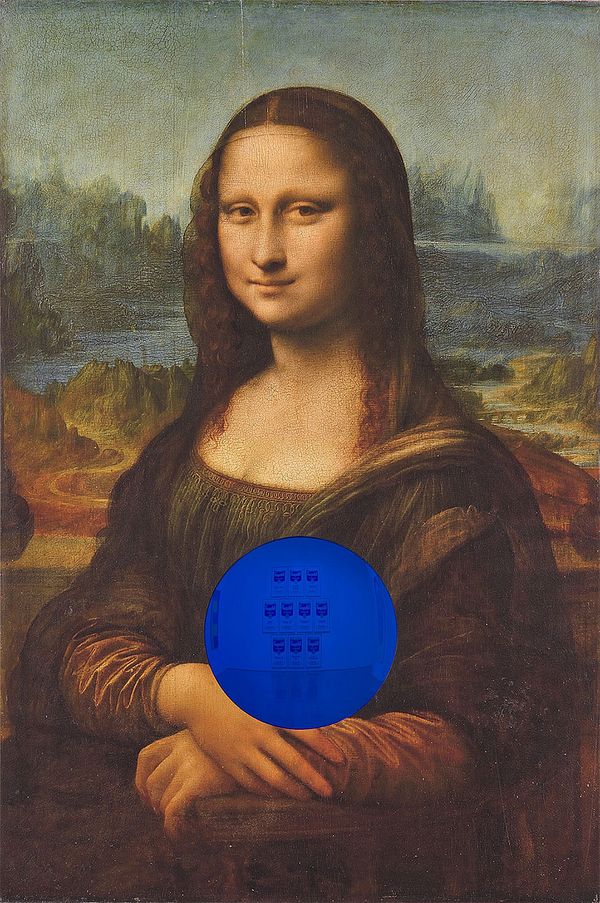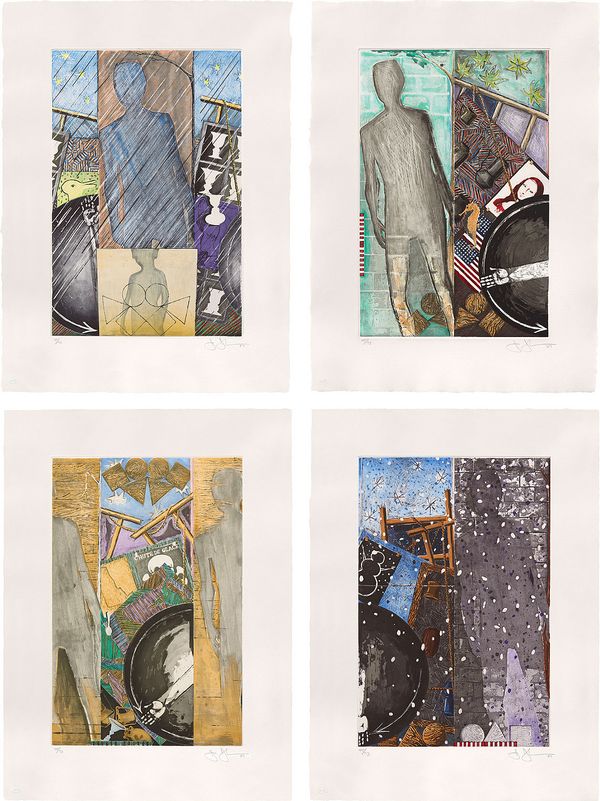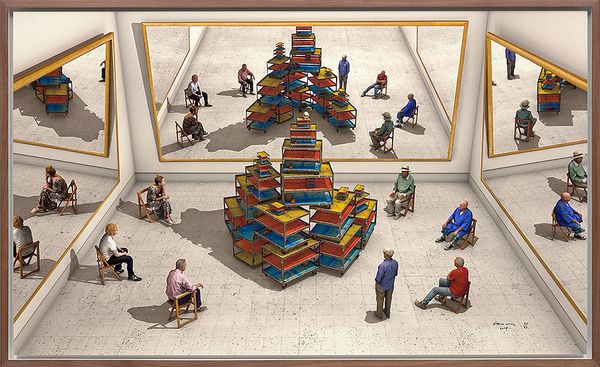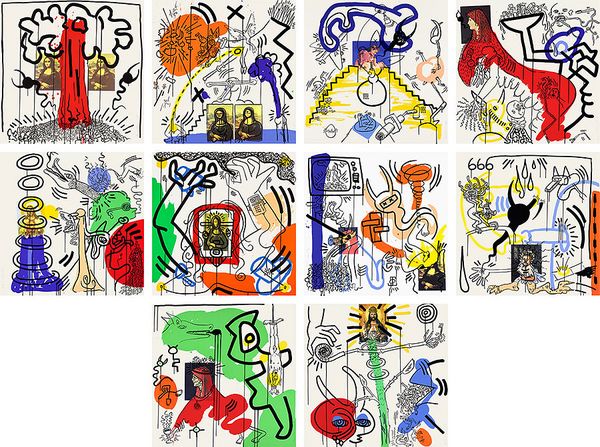Keith Haring, Apocalypse Suite (L. pp. 98-109), 1988. Editions & Works on Paper New York.
Ahead of our 19-21 April Editions & Works on Paper Sale, we picked a selection of works that bring together artists and concepts across place and time, and explore how those connections find their way into the fine details of each piece as conversations between them.
Our first link in the chain is Keith Haring’s Apocalypse Suite. Created in collaboration with author William S. Burroughs, the Apocalypse project offers a visual representation of the shifting cultural and artistic landscape of New York at the height of the AIDS epidemic. Each of the ten images are paired with an accompanying text written by Burroughs, whose automatic writing style weaves through Haring’s combinations of iconography and provocative visions of end times. We see the artist’s use of paradox through references to Dante and Heironimus Bosch and devilish figures in search of torment, and sitting among the chaos, a recurring detail of the Mona Lisa, as if stoically absorbing the end of the world through her enigmatic image.

Jeff Koons, Gazing Ball (da Vinci Mona Lisa), 2016. Editions & Works on Paper New York.
From apocalyptic visions of the future, we arrive at Jeff Koons’ Gazing Ball (da Vinci Mona Lisa), a representation of what the artist says is “the vastness of the universe and at the same time the intimacy of right here, right now.” Combining an immediacy of concept with the historical context of an image, Koons’ series recreates masterpieces with an inlaid blue gazing ball to reflect both the onlooker and the environment in which they view the piece. The gazing ball is a framing device for Koons; a chance for the artwork to connect to the world around it instead of simply being observed – in this case, the most photographed, studied, and parodied painting in the world muses on itself in discussion with whatsoever is in its reflection. On this day, we see the soup cans of a certain Pop artist.

Andy Warhol, Flowers (F. & S. 64-73), 1970. Editions & Works on Paper New York.
Fittingly for the Mona Lisa, that artist makes for enjoyable conversation. Flowers marked a unique and pivotal moment in Andy Warhol’s artistic career; a shift from his celebrity or commercial subject matter to the production of banal objects to which the public might not have otherwise given much thought – until, that is, Warhol decided that they should. The passing of an image from its novel form to a flattened, mass-consumable shorthand item is a quintessential Warholian turn, one that by 1970 had seen its development from the early days of Marcel Duchamp’s ready-mades to the era of infinite copies. The source photograph consisted of several hibiscuses which were repeatedly run through the Factory’s photostat machine until the details of the image were rendered unidentifiably flat and ready for limitless reproduction – ironically, Warhol soon after faced a lawsuit for unauthorized use of the original photo. In other words, Warhol was sued – and lost – for the very technique that defined his art.

Jasper Johns, The Seasons (ULAE 238-241), 1987. Editions & Works on Paper New York.
Jasper Johns’ iconic four-panel series The Seasons depicts the different studios where the paintings on which these prints are based were created, along with the artist’s personal artifacts and fragmented imagery from earlier works. Already referencing and reworking imagery in his art at this point in his career, in particular Edvard Munch's Between the Clock and the Bed (1940-42) and Matthias Grünewald's Isenhelm Alterpiece (c.1515), Johns turned to Pablo Picasso's 1936 work Minotaur Moving His House and its self-citation of the artist's previous paintings, borrowing much of the color scheme for his work, as well the ladder imagery seen in Winter. Along with these image fragments, we see a hand rotating counterclockwise to indicate the reversal of time, Johns’ emblematic American flag, and of course, the Mona Lisa again. Johns even instigates Ludwig Wittgenstein with a rabbit-duck illusion in Spring to draw attention to perception of seeing that versus seeing as; distinguishing perception and interpretation. Naturally, this feeds into a profile of Marcel Duchamp in Fall, and above him, a skull-and-crossbones avalanche warning: the point of no return for the image, after which all that awaits is a torrent of reflections and references.

David Hockney, Viewers Looking at a Ready-made with Skull and Mirrors, 2018. Editions & Works on Paper New York.
It is fitting, then, that we take the skull at its word and end up in a hall of mirrors, or rather, a gallery of them. David Hockney’s Viewers Looking at a Ready-made with Skull and Mirrors depicts an exhibition space flanked by three wall-length mirrors reflecting a group of spectators as they take in an assemblage of stacked metal carts. At the pinnacle rests a skull, which sits at the viewer’s eyeline, but above the crowd in the work. Hockney’s tongue-in-cheek humor is on full display in this image of shifting focus: the presence and angles of the mirrors when paired with the composition of the scene turns the viewers into participants. The figures observe themselves as they observe the sculpture and as a result, we join them as active participants when we inhabit the position of observing the work from our vantage point, taking in the entirety of the image. And the beauty of it all? The photographic drawing is a work of fiction. Hockney used multiple photographs of each person and object from countless angles and then digitally altered them together to create the scene. It is anything but ready-made.
Discover More from Editions & Works on Paper >
Recommended Reading
